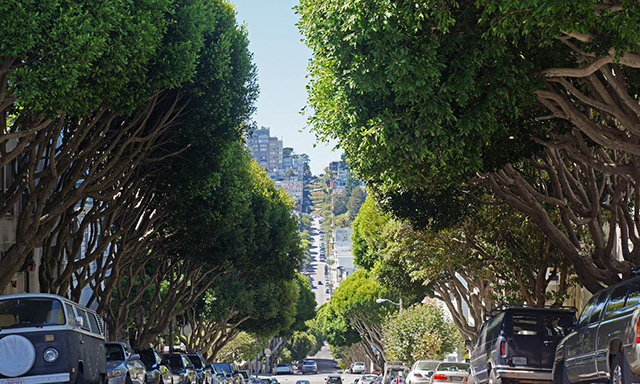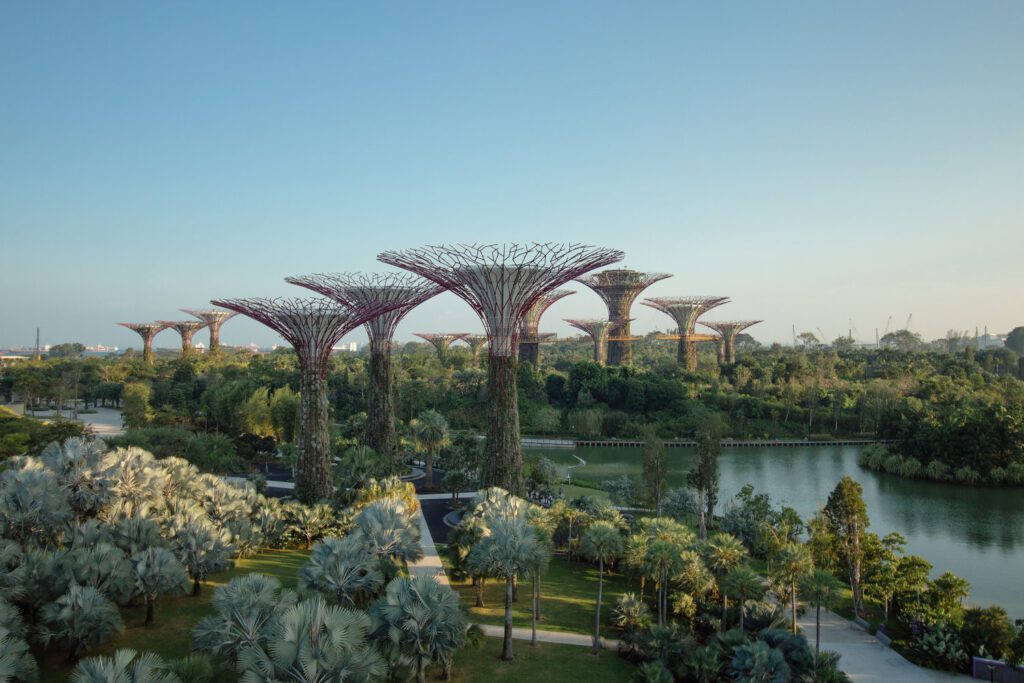

A two-part series exploring how biophilic cities can advance the goal of Half-Earth, both within and beyond their boundaries. (above image: Lombard Street, San Francisco. Image Credit: Allie Caulfield on Flickr.)
By Tim Beatley, Founder & Executive Director of Biophilic Cities; Teresa Heinz Professor of Sustainable Communities, University of Virginia
E.O. Wilson has given us two essential and interrelated ideas suited to the times we are in: Half-Earth and Biophilia. The goal of setting half the planet aside for nature is a bold and necessary vision, for human and non-human survival, while biophilia, our species’ innate love of life and living systems is a necessary buttress for the commitments and steps we must take to bring it about.


We are increasingly an urbanized planet and so cities play an extraordinary role in shaping the lives and health of humans and planet Earth. Biophilic Cities reflect a love and care for nature and place nature at the center of their design and planning. Half-Earth will require concerted work by many different organizations and actors at different societal levels to bring it to reality, and cities must be included. Biophilic Cities have many opportunities to advance the goal of Half-Earth, both within and beyond their boundaries, and they can and must take strong actions and leadership. We believe Biophilic Cities, in their complementary work to make nature a more central feature in urban life, can also be viewed as Communities for a Half-Earth Future.
In this two-part series, I first examine examples from the Biophilic Cities Network of cities promoting opportunities for abundant biodiversity to flourish within cities. These efforts include the creative dedication of new urban spaces to support species and their habitat. In the second part of the series, I explore how cities can support the Half-Earth vision beyond their boundaries by helping to conserve the ecological hinterlands on which they depend, limiting their ecological footprints and contributing to global biodiversity commitments.
Part One: Abundant Biodiversity within the City
Increasingly, the design and planning of cities is placing nature at the center of urban life. This is the key insight behind the vision and global movement around Biophilic Cities. It is a recognition that nature is essential in our urban life; necessary for flourishing human lives. This is something the global pandemic has demonstrated compellingly, as we seek solace and support and constancy from the nature around our homes and in our cities. Our Biophilic Cities Network has been gaining traction and visibility and we now have twenty-three official Partner Cities (as well as dozens of organizational partners and a larger community of several thousand individuals). Cities wishing to participate must formally adopt a resolution stating an intent to join the Network and to aspire to becoming more biophilic. To this end, the cities must identify steps they plan to take in the future as well as appropriate metrics by which to monitor progress.[1]
While the extent of the global area that comprises cities is relatively small–in the range of 1-3%–the growth and development of cities can significantly help to advance the Half-Earth agenda. Many fast-growing cities are located in or near biodiversity hotspots, and their prevailing patterns of low-density sprawl take a high toll on nature. A more compact urban form can help to reduce these impacts and the extent to which urbanization infringes upon nearby protected areas.
The vision of Biophilic Cities is one of living within immersive nature–rather than understanding cities as places where nature can be found (and can be visited); it is a bolder vision of urban neighborhoods and, therefore residents, seamlessly embedded in a verdant and biodiverse urban environment. It is a city not to be understood as a place with parks or forests of gardens–but rather as a forest, as an ecosystem. Implementing this vision of deeply natureful cities will in turn contribute to achieving Half-Earth, though few dense cities will be able to set aside half their land area in parks. There is evidence though that cities are embracing some form of the “half-city” nature goal. The City of Paris recently set the ambitious target of achieving a 50% green cover by 2030, through a variety of projects including new urban forests and the installation of schoolyard “oases,” that also help to address the city’s challenge of addressing urban heat.[2]


Many cities are finding creative ways to achieve these nature targets–for instance converting rooftops to meadows and portions of roadways and parking lots to urban forests. In Singapore, one of the Biophilic Cities Network’s original Partner Cities, Landsat imagery confirms that about half the area of the city is now in green cover. Some of it is found on rooftops like those at Kampung Admiralty, a WOHA-designed multi-story mixed-use social housing development project, with its layered rooftop almost entirely covered by a tropical forest.
Ecological rooftops are one way a city can foster more nature and biodiversity and several of our partner cities have been pioneering here. With an estimated 30% of its land area in rooftops, San Francisco seeks to make a major impact by mandating installation of green roofs, the first US city to do so (vegetated or solar roofs, or a combination, are required under its Better Roofs Ordinance[3]). Another partner city, Portland, OR, followed close behind, requiring eco-roofs for larger new buildings, under its Central City 2035 plan.[4]
The rise in biophilic buildings and design presents a promising opportunity to advance a Half-Earth goal in cities. Singapore, again, is a model, and demonstrates how it is possible to multiply the amount of nature lost at ground-level with abundant nature in the vertical realm (and a minimum one-to-one replacement is now required under the city state’s LUSH standards). Another WOHA-designed project, the Oasia Downtown Hotel, is an example and boasts a 1200% replacement of ground-level nature with vertical nature, much of it in the form of an exterior cladding that includes twelve varieties of flowering vines and that provides habitat for birds and other urban biodiversity. Half-Earth cities can find ways to set aside more ground-level parks and wild spaces but their ability to grow up, as well as out, suggests one important way they can multiple and magnify efforts at protecting and restoring habitat.
We believe that Biophilic Cities must work to share urban spaces with many other forms of life and that this is important partly to further health, happiness and meaning to those living in cities but also because we are duty-bound to do so on behalf of the other living creatures cohabitating spaces with us.
Our partner cities already have a remarkable history of conserving and protecting parks and nature. Large and quite biodiverse parks include Sutton Park in Birmingham, UK (about 2400 acres), Forest Park in Portland (about 5100 acres) and the desert and mountain parks in Phoenix (totaling more than 40,000 acres and including parks such as South Mountain’s 16,000 acres). Many of our cities have undertaken creative efforts at the other end of the spectrum—repurposing smaller leftover spaces, such as converting vacant lots into pocket parks (Milwaukee), setting aside steep hillsides (Pittsburgh), encouraging residents to plant (hundreds) of butterfly gardens (St. Louis), inserting nature through parklets, sidewalk gardens and street parks (San Francisco).
Another important epiphany from our collective pandemic experiences is the important ways many cities are re-thinking streets and automobile spaces (that in many cities take up as much as half the city). Designation of Slow Streets in cities like San Francisco, while temporary, will likely usher in (or further along) permanent post-pandemic space re-adjustments, with the chance to shift more space in the direction of nature and biodiversity. The green streets of Portland, living alleys in San Francisco, and superblocks in Barcelona, are a few of the ideas already in play in partner cities for how to at once reduce our dependence on cars, enhance safety and quality of life, and also grow more nature.[5]
There are also remarkable stories among our partner cities of efforts at ecological and habitat restoration within the city—for instance, Vitoria-Gasteiz’s (Spain) efforts at restoring its Salburua Wetlands (from degraded site to a RAMSAR-designated, important habitat for migratory water birds), or Washington, DC’s impressive success in restoring the Anacostia River (though there is much more to do), among many others.
We believe that Biophilic Cities must work to share urban spaces with many other forms of life and that this is important partly to further health, happiness and meaning to those living in cities but also because we are duty-bound to do so on behalf of the other living creatures cohabitating spaces with us. We know that it is possible to design buildings, neighborhoods and cities that make room for a rich diversity of life and this is becoming a priority in cities.
Life during lockdown has opened new possibilities for how cities could be more biodiverse. This is partly about converting existing green or vacant spaces in cities (even parks) to spaces and habitats that will be much more ecologically beneficial. A two-month lockdown in Singapore, for instance, necessarily resulted in fewer spaces being regularly mowed. For residents, this has meant more sightings of butterflies and birds and suggesting that post-pandemic residents may support a wilder, and more biodiverse management approach.[6] This is good from a Half-Earth perspective and other cities have been going through a similar re-think.
[1] For more information about requirements for joining the Network see https://www.biophiliccities.org/
[2] See “Urban forests soon on four emblematic sites,” June 18, 2019, found here: https://www.paris.fr/pages/des-forets-urbaines-bientot-sur-quatre-sites-emblematiques-6899/; also see Megan Clement, “Green space in every schoolyard: the radical plan to cool Paris,” The Guardian, August 16, 2018, found here: https://www.theguardian.com/cities/2018/aug/16/could-greening-every-paris-schoolyard-cool-the-city
[3] San Francisco Planning, “Better Roofs,” found here: https://sfplanning.org/project/better-roofs
[4] “Portland Adopts a Green Roof Requirement in the Central City 2035 Plan,” Living Architecture Monitor, June, 2018, found here: https://livingarchitecturemonitor.com/news/2018/6/14/portland-adopts-a-green-roof-requirement-in-the-central-city-2035-plan
[5] For more information on many of these efforts see Beatley, Handbook of Biophilic City Planning and Design, Island Press, 2017.
[6]This is part of a longer-term discussion about how the city sees itself, with some arguing for the need to shift from “City in a Garden” to a “City in Nature,” which implies less human management or cultivation (a garden) and more wildness. See “Can Singapore, the city in a garden, grow into a city in nature?,” found here: https://www.eco-business.com/news/can-singapore-the-city-in-a-garden-grow-into-a-city-in-nature/

